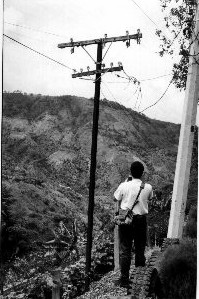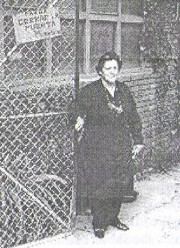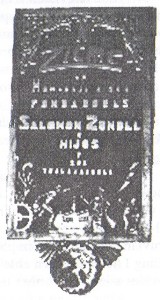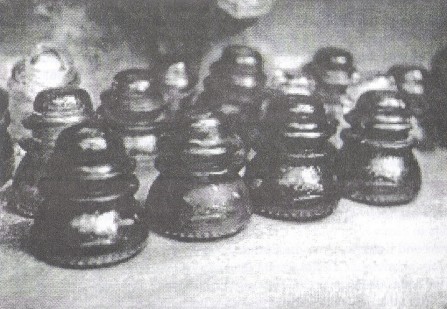In Search of the Crown Jewels of Colombia
by John T. Nasci
Reprinted from "Crown Jewels of the Wire", July 1998, page 4
Insulator searches on previous trips to Colombia proved fruitful to my friend
and fellow insulator enthusiast, Vince Reh, and myself, so we decided to give it
another try and took off once again for the intriguing and beautiful South
American country better known for its illegal drug production and internal war
against Marxist guerrilla insurgents than its uniquely shaped and colored glass
insulators. Interest in insulators put aside, our concern for personal safety
while in Colombia was always of utmost concern and satisfied by the
accompaniment of our Colombian friend, artist and fellow insulator enthusiast,
Hernando Hoyos.

As with previous trips, we met Hernando in Bogota, the nation's
capital of approximately four million people and made our base a less than
luxurious but affordable hotel in La Candelaria, the oldest section of the city.
From this base we had various insulator hunting excursions planned but the most
interesting event happened by chance on a drive to Zipaquira to see the Salt
Cathedral, a truly amazing sight consisting of cathedral several hundred feet
below the ground carved completely out of salt deposits from an abandoned salt
mine. On the road to Zipaquira, driving through the northern, industrial Bogota
suburb of Fontibon, we noticed a sign with the Zicme logo on it and immediately
stopped the car to investigate further. After Hernando spent several minutes of
conversation with a lady at the gate, he discovered that this was indeed the location of the
present day Zicme operations. There were another few minutes of intense
negotiations, necessary mainly to convince the lady that we were legitimately
interested in learning information about the company and not a group of
criminals, before our entrance into the plant was secured.

Then to our surprise
we were greeted and welcomed inside by Liza Zundel de Farine, the daughter of
the late Salomon Zundel, the founder of Zicme. Mrs. Zundel is the present owner
and manager of the business and was very surprised that anybody would be
interested in the company, let alone be interested in collecting the glass
insulators which the company once produced. Nonetheless she showed us great
hospitality by setting aside the business of the day, serving us some
refreshments and giving us about an hour of her time to ask questions of her
about the business.
As we entered the front office of the plant, immediately
noticeable mounted on the wall was a bronze plaque presented to Zicme by EEB,
the Bogota electric power company, in thanks for service in the provision of
insulators and other electrical products to EEB. The plaque reads: "To
Zicme, Homage to Your Founders, Salomon Zundel & Sons and Your
Workers". The years" 1956" and" 1961" appear in the top
left and right corners representing the years of insulator production.

Mrs.
Zundel was a stout but firm woman in her sixties who spoke English as well as
she spoke Spanish. She was very determined to carry on the business her father
built from scratch as a Lithuanian immigrant to Colombia and told us that, to
her father, the most important principle was to keep the company name going, which she has done and continues to do. She related to us that the plant had
survived two fires both of which required rebuilding from scratch. Although the
company now operates as Pelicme (Productos Electricos Liza Industrio Colombiano
Materiales Electricos), all the products including fuses, electrical switches,
telephonic terminals, etc. carry the same Zicme logo as was embossed on the
glass insulators years before. She also has a strong sense of loyalty to her
workers who she avoids laying off and keeps employed through rough economic
times as it has been for the past couple years in Colombia.

When asked about the
remnants of the insulator production, Mrs. Zundel had some of her employees
mount an all-out search of the facility. Unfortunately they were not able
to find anything. She then told us of her father's personal insulator
collection, consisting of 30 or 40 pieces and how it was destroyed inadvertently
during a recent move to the present plant facilities. We all cringed silently
when we heard this. As if to soothe our pain, she showed us a beautiful glass
vase that was an example of the products that the company made for a short while
after it ceased insulator production in the 60's.
On a television stand in the
office I noticed a porcelain ashtray in the shape of a typical power insulator
with a saddle top. Upon our inquiry, Mrs. Zundel told us that it was a gift of
the Gamma insulator company which presently makes porcelain insulators in
Colombia. Until this time we were not aware that a company named
"Gamma" produced insulators. However a later perusal of the Bogota
phone book produced a listing for Gamma. We also found a damaged Gamma insulator
a couple days later but left it behind given its unknown value and the extra
weight it would have added to our baggage.
We proceeded to ask several questions
about Zicme insulator production, most of which confirmed facts already known.
However, we were surprised to learn from Mrs. Zundel that insulators marked
"VI-BO" which have been found in Colombia were products of a Peruvian
company and imported to Colombia. At the time of this writing I have not been
able to confirm this but at the very least it provides a lead for further
investigation.
After asking a few more questions about the company, we thanked Mrs. Zundel for her hospitality and generosity in spending time with
us and departed for the planned part of the day.
The next day we boarded the
"Tren Turistico", a restored steam locomotive and the only operating
passenger train remaining in Colombia, for an all day ride. As with most
insulator buffs, our heads were constantly out the windows peering up at the
glass on the communications lines paralleling the tracks. Of course being in
Colombia our eyes were also taking in a lot of the beautiful scenery of the
Andes Mountains on either side of the valley in which the rail line ran. As the
train progressed along the route, a band moved from car to car playing Latin music to which people instantaneously jumped up and started dancing. It was
quite a feat to take in the festive atmosphere and the beautiful scenery and
still be able to keep an eye on the insulators.
Nonetheless, the train's top
speed of a brisk 12 kilometers per hour, due to the deteriorated condition of
the tracks, made insulator watching fairly achievable. The line construction
consisted of poles made of 30 to 40 feet long sections of steel railroad rails
with one or two cross arms and some side pins. And as with most of these lines,
this one had been abandoned and was mostly fallen down. Unlike the United States
where insulators may lay on the ground for a hundred years until found by a
collector, in Colombia "recyclers", Colombian scavengers, take just
about anything they find on the ground as soon as it hits the ground. Needless
to say, we saw very little on the ground. In the air however we did see some
interesting pieces, including CD-154s in clear, light purple, CD-447s in dark
olive green, CD-203s in straw and light purple and a European-looking insulator
in dark olive green, possibly a CD-574.2. On the sides of stations along the way
we spied some Brookfield CD-102s and Hemingray CD-122s, both in traditional
Brookfield and Hemingray colors.
At one station stop we got off the train and,
upon wandering around, we found several Zicme CD-154s, clear and purple lying in
a pile on the ground between rails. After amusing the guards with our request to
partake in a few glass souvenirs, we rummaged through the pile and found one
clear Zicme CD-154 and one purple Zicme CD-154 in good enough shape to take
home.
Unfortunately, that was the extent of our insulator hunting on this trip,
other than peering through bus windows as we traveled from city to city. Due to
the heightened violence surrounding presidential elections which included bombs
found in two of the cities we visited and the heightened presence of police and
military on every street corner, we deemed it impractical and unsafe to do any
searching ourselves. We will have to leave the yet-to-be-found Colombian glass jewels to future trips.
This trip was not a loss, however, as Hernando had
several beautiful pieces waiting for us upon our arrival at his home in Pereira.
Among the pieces were several medium-purple Zicme CD-154s, a couple Zicme
CD-203s in purple and green and a couple clear top-embossed Zicme CD-154s. Our
backs still feel the pain of lugging these gems through three international
airports and numerous customs checks in an effort to get them home. However, as
the memory of the pain subsides, the beauty of the glass and the memory of the
adventure of the hunt lives on.

Vince, Hernando and I will be showing these insulators and many more
Colombian pieces at the National Insulator Show in Williamsburg, Virginia in the
end of July. We hope to see you there. Happy hunting.
| 